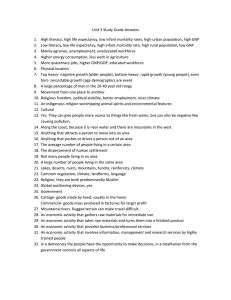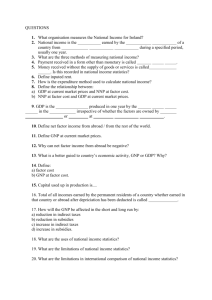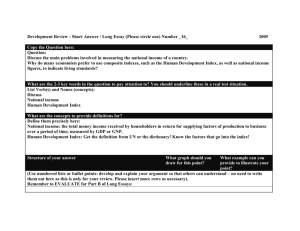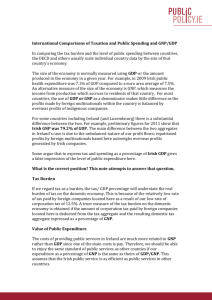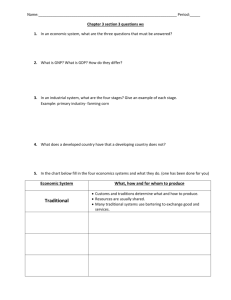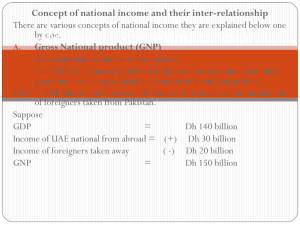8 NATIONAL INCOME
advertisement
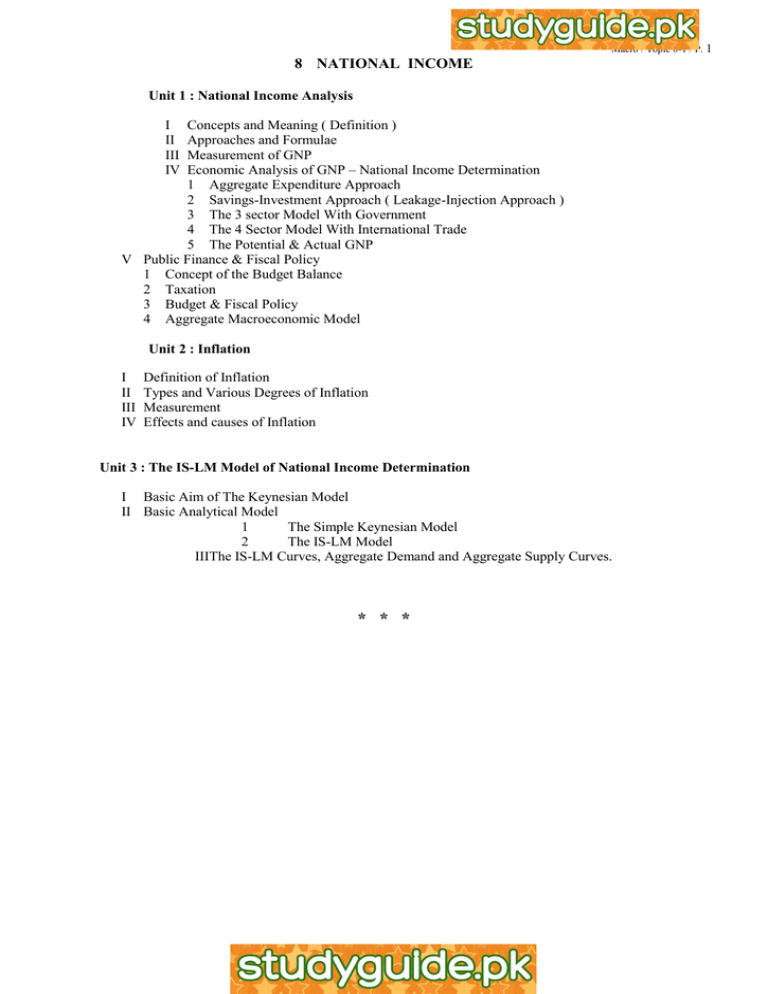
Macro / Topic 8-1 / P. 1 8 NATIONAL INCOME Unit 1 : National Income Analysis I II III IV Concepts and Meaning ( Definition ) Approaches and Formulae Measurement of GNP Economic Analysis of GNP – National Income Determination 1 Aggregate Expenditure Approach 2 Savings-Investment Approach ( Leakage-Injection Approach ) 3 The 3 sector Model With Government 4 The 4 Sector Model With International Trade 5 The Potential & Actual GNP V Public Finance & Fiscal Policy 1 Concept of the Budget Balance 2 Taxation 3 Budget & Fiscal Policy 4 Aggregate Macroeconomic Model Unit 2 : Inflation I II III IV Definition of Inflation Types and Various Degrees of Inflation Measurement Effects and causes of Inflation Unit 3 : The IS-LM Model of National Income Determination I Basic Aim of The Keynesian Model II Basic Analytical Model 1 The Simple Keynesian Model 2 The IS-LM Model IIIThe IS-LM Curves, Aggregate Demand and Aggregate Supply Curves. * * * Macro / Topic 8-1 / P. 2 Unit 1 : National Income Analysis The Relation between National Product, Expenditure & Income Suppose a self-sufficient nation produces the following products in a certain year for their citizens : Market Value ( $ Million ) 10 4 8 6 25 15 Products ( Goods & Services ) Books and magazines published Garments Electrical applicances Toys Taxi fares or revenue Agricultural products Total market value of products / outputs HOUSEHOLDS FIRMS National Expenditure = National Income = Production gives rise to outputs. Production generates income. What is national income ? How is it calculated ? Outputs stimulates expenditures. What can it represent ? Expenditures depends on income. Macro / Topic 8-1 / P. 3 I. Concepts & Meaning ( Definition ) Gross National Product ( GNP ) is the market value of all final goods and services currently produced by the citizens of an economy in a time period ( usually a year ). The main ideas embodied in this definition include : It is a flow concept within a time period. It is measured by the market value of a time period. It only counts those final goods and services. It records all marketable transactions. It refers to all currently produced goods and services, not stocks. It is a record of production activities in the accounting sense. Uses of G N P It is a measure of the actual flow of goods and services in terms of money. It tries to reflect the overall economic performance or activities of an economy. II. Approaches and Formulae HOUSEHOLDS PRODUCT MARKET FIRMS GNP can collectively represent the 3 different measures of the flows of products or income in the circular flow of an economy based on : the expenditure approach ; the output or value-added approach ; and the income approach. Formulae : GNP at current market prices = C + I + G + X – M ( an open economy ) GNP – Depreciation = Net National Product ( NNP ) Depreciation = Gross Investment - Net Investment GNP – Net ( factor ) income from abroad = GDP GNP – Indirect business taxes + Subsidies Wages + Interests + Rents + Profits = GNP at factor cost = National Income ( measured at factor cost ) National Income + Depreciation = GNP at factor cost National Income – Corporate income taxes – Undistributed profits ( Retained earnings ) + Transfer payments from government = ( Gross ) Personal Income Personal Income – Personal income taxes + Transfer payments from government to households = Disposable Personal Income ( DPI ) Macro / Topic 8-1 / P. 4 Expenditure Approach Income Approach X-M Net factor income from abroad G Depreciation Indirect business taxes less subsidies N G I Depreciation Profits Interests Rents Wages N D P P C G N P at current market prices GNP at factor cost N I GNI III. Measurement of GNP GNP represents the market value of goods and services produced by definition. If there is any change in the market prices of the goods and services, the total market value calculated will change as a result. Example Outputs Vegetable Fruits Garments 1990 P 1 2 4 1998 Q 50 60 70 P 2 3 6 Q 60 70 80 GNP at current market prices ( Nominal GNP ) of 1998 = GNP at constant market prices ( Real GNP ) of 1998 = In reality, it is costly to find out all the prices of the products to get the 2 values of the GNP above. Therefore, the compilation of price index is used to simplify the calculation. In theory, the proportion of the price indexes of two different years should be the same as the proportion of nominal GNP to real GNP of any year because the two values of GNP differ only by the price level, i.e. Nominal GNP / Real GNP of any year = PC / PB OR : Real GNP of a year = Nominal GNP of the year X ( PB / PC ) Where PB : price index of the base period ; PC : price index of the current period. The value of PC is usually greater than that of PB due to the existence of inflation. In economics, the value of ( PB / PC ) is called the GNP deflator because it helps to cancel out the effect of inflation on the value of GNP of the year. In economic language, it deflates the nominal GNP to become a real variable – the GNP at constant market prices or the real GNP. Macro / Topic 8-1 / P. 5 Per Capita GNP & Growth Rates of GNP Per capita GNP is more meaningful in comparing the economic activities of 2 nations with different working population. Based on the example, the growth rates of GNP are : Nominal growth rate of GNP ( Growth rate of nominal GNP ) from 1990 to 1998 = Real growth rate of GNP ( Growth rate of real GNP ) from 1990 to 1998 = The difference in the two growth rates denotes a significant change in the price level, i.e. inflation, over the period – 1990 to 1998. IV. Economic Analysis of GNP – National Income Determination Economists are interested to know about the equilibrium value of national income of an economy. The economic analysis is to determine the value of this level of national income. The Simple Keynesian Model The World Depression began in 1929 shock the world as well as the economists. Everyone wanted to know what was wrong with the economy. They tried to find the suitable means to avoid depression and to bring back economic growth again. John Maynard Keynes ( 1883-1946 ) argued that this state of unemployment and disequilibrium were due to insufficient demand of the economy. If demand is insufficiently large to absorb the marketable goods, producers might simply find their stocks piled up. The excess supply made the producers to reduce the outputs and the labour employed. The level of production, the employed workers and their factor income eventually fell. The overall demand would in turn become even smaller. Thus, Keynes believed that – Demand creates its own supply. ( The classical economists believed that supply creates its own demand. ) 1 Aggregate Expenditure Approach This approach assumes the following conditions : It is a short run analysis. ( “In the long run, we are all dead.” ) Production of consumer goods and producer goods can generate national income. There is a circular link among the variables : Expenditure ( GNE ) Demand Production of goods and services ( GNP ) National Income ( GNI ) Consumption Demand. There are unemployed resources. As a result, supply can be changed to suit the desired level of aggregate demand of the economy. ( Demand creates its own supply. ) The price level is held constant for simplicity, i.e. the real GNP and nominal GNP are the same. The Analysis The Expenditure or Demand Side GNE or AD = C + I C : the planned consumption expenditure of the household sector. I : the planned investment expenditure of the firms. In a most simplified case, there are only 2 independent sectors in the economy – the households and the firms. These two types of expenditures make up the level of aggregate demand or GNE. The Income or Supply Side GNI = GNP = AS = C + S Production ( GNP ) generates income ( GNI ). Production also denotes the level of aggregate supply ( AS ). Without the government sector, and taxation, our income is either consumed ( C ) or saved ( S ). Savings become a flow of non-disposable income per unit of time. Macro / Topic 8-1 / P. 6 An Example Income ( Y ) C 200 225 250 275 300 325 350 210 230 250 270 290 310 330 S I ( planned ) 10 10 10 10 10 10 10 Changes in unplanned inventory - 20 G N E or AD Given a series of values of income ( generated by a corresponding series of production ), this leads to a series of planned or desired consumption expenditure decided by the households. Assume that investment expenditure is fixed at 10, i.e. firms make investment by some consideration other than income, to be explained later. At a certain level income and output, there is a resulting level of aggregate demand represented by the sum of C and I. As households and firms make decisions independently, the level of aggregate demand needs not be the same as the level of actual aggregate supply. The difference leads to the so-called “ changes in unplanned inventory “. If the planned amount of investment expenditure ( I ) is added to the unplanned amount, the gross investment can be further added up with C to maintain the condition of : AD = AS. The concept of planned and actual variables is very important in this approach. Investment expenditure is all those money spent by firms, no matter it is for the purchase of capital stocks or the allowance on capital depreciation. It raises the production capacity as a result. The Graphical Analysis The AD & AS Curves The Savings & Investment Curves 300 10 5 200 0 Y -5 -10 100 100 200 300 Summary of This Approach This approach suggests that supply of firms can adjust to different levels of demand ( = C + I ) to maintain a state of equilibrium with : G N E = G N I = G N P. Macro / Topic 8-1 / P. 7 2 Savings-Investment ( Leakage-Injection ) Approach This approach is more or less the same as the first approach. It further adds in the concept of leakage ( which refers to savings here ) and the concept of injection ( refers to investment here ) to explain the level of equilibrium income. In equilibrium : AD(=GNE) = AS(=GNP=GNI) C + I = C + S I = S Non-consumed output for further production (I) = Income not spent on consumption (S) If the amount of AD is greater than that of AS, inventories will fall. Firms will produce more and generate more income until AD = AS. The level of employment is also increased. If the amount of AD is smaller than that of AS, the actual level of AS will be greater than the sum of planned C + I. The opposite adjustment of the above process will occur until an equilibrium is reached again. The Keynesian Functions On Consumption, Savings & Investment The Consumption Function In its simplest form, this function suggested that the amount of consumption expenditure of the household sector depends mainly on the amount of ( disposable ) income generated from the production activities of an economy. In general, C = f ( income, wealth, taste, expectation on prices, interest rates. ) In its simplified form, C = f ( income ) In a simple mathematical form, C = a + b. Y Where : a : autonomous spending or expenditure b : marginal propensity to consume ( MPC ) which lies between zero and one. b.Y : induced spending or expenditure Numerical Example Given a consumption function in the form : C = 240 + 0.8 Y Consumption Function : C 1200 Income (Y) C 0 240 200 400 800 600 800 400 1 000 1 200 Y 400 800 1200 1 400 Savings Function : S = Y - C 0 -200 Income C = a + b. Y C/Y=a/Y + b APC = a / Y + MPC APC + APS = 1 MPC + MPS = 1 C/Y Macro / Topic 8-1 / P. 8 Implication When income increases, the value of APC will fall because C increases at a lower rate than Y with the value of b being smaller than 1. That is, APS increases with income. In other words, the relatively high-income group saves a larger proportion of their income than the relatively lower-income group. The value of MPC refers to the additional amount of consumption expenditure when an additional amount of income is earned. Together with the MPS, it shows the consumption and saving behaviour of the households. Factors Leading To Changes In Consumption the value of liquid assets, e.g. bonds, stocks and gold ; the amount of durable stocks ; the expectation on prices ; the degree of consumer indebtedness ; the attitude of people towards thrift ; the government policies like the taxation system ; the distribution of income – the APC of the relatively low-income group is greater than the APC of the high-income group. Savings Function Saving refers to the change of wealth over time. It is a flow. Wealth refers to the amount of savings or stocks accumulated from the past savings. Savings is the amount of money not immediately consumed for any purposes. Saving may also refer to the act of sacrificing present consumption for the future. Investment Function Investment function is a spending on accumulating capital (goods). It is a derived demand affected by the cost of borrowing or holding money. It is an exogenous ( predetermined ) variable in this simplified model, i.e. the money market is assumed to be in equilibrium. Investment also leads to capital formation. The investment function can lead to the optimal or most desirable level of capital stock which in turn determines the level of output. The Concept of Multiplier Production generates income. Income gives rise to consumption expenditure which becomes the income earned by other firms. The income earned will induce a flow of expenditure again, according to the consumption function. An initial change in expenditure will induce income of a sector. The circular flow of income and products starts its circulation with the second round, third round. This leads to a multiplier effect on the national income within a period. The economy is stimulated by the initial round of spending. The Paradox of Thrift People traditionally think that the more a person saves his income or wealth, the more the amount of income gained in the future. Savings can increase future income as well as output. The more we save, the more income we shall have. Based on the Keynesian functions, savings depends on income. We have to cut our consumption expenditure in order to save more. By the multiplier effect, the fall in consumption will lead to a fall in income or GNP. And with this smaller amount of income, we can then save less than before. The more we save, the less income we shall have as a result. It is paradoxial to find that : If people try to increase their savings, they will end up saving less. It then follows that : When times are tough ( economically unfavourable ), we should not tighten our belts. It is called a paradox ( of thrift ) because the act of a single person to save more for the future is not directly applicable to the whole economy. Thrift for an individual is fine but not for the economy. Why ? Macro / Topic 8-1 / P. 9 Why is there a paradox ? Fallacy of Composition ( What is good for one is also good for all. ) What is good for one may not be good for all. A good example is the taking of medicine. What is good for you to take a certain medicine may not be good for others. Saving is good for a person but is not desirable for the whole economy. Economic Situation The traditional view carries the concept of self-adjustment of the economy with savings and investment moved in the same direction to maintain an equilibrium output. Whereas the Keynesian view argued that there is no apparent linkage between savings and investment. That is, when savings rises and consumption expenditure falls, the multiplier effect leads to a fall in income also. The amount of investment is not affected by income. As a result, the paradox may exist. Necessary Conditions For the Paradox of Thrift Unemployment exists so that more consumption can lead to a rise in income. If there is already fullemployment, income and output cannot be increased even with a rise in consumption expenditure. Savings and investment should be independent of each other. Some economists argue that S & I are decided by many different groups or sectors in an economy. The change in savings has no mechanism to lead to a change in investment, and vice versa. The paradox of thrift helps to point out the conceptual importance of the relationship between S & I. If there is any link between the two variables, this linking item or variable is significant in the macroeconomic analysis. 3 The Three Sector Model With Government In both theory and reality, government also needs to purchase some final goods and services through the product market. The amount of government expenditure spent for this purpose is an independent or exogenous variable. It is determined in the financial budget and is supported by the revenues mainly by taxation. On the one hand, government expenditure acts as an injection into the circular flow of income. On the other hand, the amount of taxes acts as a leakage from the circular flow. Taxes also affect the amount of consumption expenditure in the consumption function. As a whole, the presence of government gives rise to different cases in the Keynesian analysis of national income. Government With A Lump-sum Tax A lump-sum tax is a simplified form of taxation. It is a fixed amount of tax and leads to an opposite effect on income. Its effect on income involves a multiplier effect. In general there are 2 multipliers in the basic model – the autonomous expenditure multiplier and the lump-sum tax multiplier. The former gives a positive effect on income while the latter gives a negative effect on income. If there is a balanced budget, there is the so-called balanced budget multiplier. A balanced budget can also lead to an expansionary effect on national income. The Balanced-Budget Multiplier It refers to the multiplier effect of a change in government expenditure, together with an equal change in taxes so as to maintain a balanced budget at the same time. That is, an increase in government spending, accompanied by an equal increase in taxes, increases the level of income by exactly the amount of the increase in government spending. The major point is that a balanced budget change ( say, a cut ) in government spending changes ( lowers ) the equilibrium income. The change in government spending has a stronger impact on equilibrium income than the same amount of change in taxes. A dollar cut in taxes leads only to a fraction of a dollar’s increase in consumption spending, the rest being saved, while the government spending is reflected dollar for dollar in a change in aggregate demand. The balanced budget multiplier is exactly 1. ( In some other sophisticated model, this multiplier may be less than 1. ) Macro / Topic 8-1 / P. 10 Government With A Proportional Tax A proportional tax is a tax based on a fixed percentage of the income earned. With a fixed percentage, the higher the income earned, the greater the absolute amount of tax will be. The effect of a proportional tax on income is calculated by the value of the proportional tax multiplier. Government activity acts as an exogenous variable in the model. At the same time, government expenditure is financed by taxation. The amount and form of tax bears an offsetting effect ( compared with the effect of G ) on the level of equilibrium income. Any variable carrying such an offsetting effect on income is termed a built-in stabilizer of the economic model. The Automatic or Built-in Stabilizers They are also called automatic tools of fiscal policy. They refer to all those institutional arrangements that automatically increase the government deficit ( or decrease the government surplus ) during recessions ; and increase the government surplus during booms ; without any decisions on government policy. They are called stabilizers because they reduce the response of national income to any economic shocks in the economy. They are anything that reduce the marginal propensity to consume out of national income and hence, reduce the multiplier. They lessen the magnitude of fluctuation in national income caused by autonomous changes in such expenditures like investment expenditure. Examples of these stabilizers include : progressive ( income ) tax system ; social security allowances ; unemployment insurance ; agriculture support programmes ; income-support programmes. They are built-in because once they are used, they will automatically exist in an economy to affect the fluctuation in national income of that economy. 4 5 The 4 Sector Model With International Trade The above analysis is confined to a closed economy. For an open economy, the effect of export and import had to be considered. The value of export depends mainly on foreign demand condition. So, export is an exogenous variable. Import depends on the local demand and income earned. The Potential & Actual GNP Potential GNP is the level of income under full-employment. Any economy has its potential to fully employ its resources to reach this level of output and income. If demand is insufficient, the economy may reach an equilibrium state with its actual income smaller than the potential income. In a graph, there exists a so-called deflationary gap. If demand is in excess of supply even at the potential output, the opposite exists and it is called an inflationary gap. As the simple Keynesian model assumes a fixed price level, the effect of a change in price cannot be treated in this context. The detailed adjustment is left for more advanced courses. An Inflationary & Deflationary Gap Macro / Topic 8-1 / P. 11 V Public Finance & Fiscal Policy 1 Concept of The Budget Balance The budget balance affects not only the product market but also the state of equilibrium of the economy. The Equilibrium of An Open Economy C + I + G + X-M = C + S + T I + G + X = S + T + M Injections = Leakages Rearranging the terms, (G–T) + (X–M) = S–I ( +ve / -ve ) + ( -ve / +ve ) = 0 The first bracket ( G – T ) refers to the budget balance. The second one ( X – M ) denotes the level of net export or the level of trade activities. The right hand side may be treated as a state of equilibrium of the money market if interest rate is at equilibrium, i.e. S = I and the left hand side becomes zero. If the level of savings and investment is the same, a state of equilibrium of the economy requires that the budget balance must be a value in opposite to the value of the net export / import. If there is a trade balance for the economy, the budget balance had to be equal to the difference between savings and investment. An expansionary fiscal policy calls for a deficit budget. A contractionary fiscal policy calls for a surplus budget. The use of suitable budget depending on different economic situation is called discretionary fiscal policy. It is also called the fine tuning of the economy. 2 Taxation The taxation principles ( equity or equality, certainty, economy, convenience ) and the form of tax system have stabilization effects on the economy. The consideration of different forms of taxes leads to issues on value judgement rather than issues on positive analysis. (1) There are mainly 2 approaches on the principles of equity. Benefit Principle Taxpayers contribute in line with what they may receive from the government. Ability-to-pay Taxpayers contribute in line with their ability-to-pay. It meets the problem of redistribution better but the provision of public services is also undetermined. Based on the ability-to-pay principle, equity is viewed from 2 angles : Horizontal Equity People with equal economic capacity should pay the same amount of taxes. Vertical Equity People with greater ability should pay more accordingly. The level of economic capacity may be measured by the level of income or consumption. A tax on income is considered to have a wider tax base compared with a tax on consumption. (2) Sales Tax It is inferior on equity ground to an income tax. A broad-based sales tax is most likely to be regressive. A relatively narrow-based sales tax is too discriminatory to those consumers / taxpayers. A sales tax together with a progressive income tax may lower the degree of regressivity but there is still an absolute tax burden on the lowest income group. A retail tax is the simplest form of sales tax. A value-added tax is far more complicated. Macro / Topic 8-1 / P. 12 Requirement of A “ Good “ Tax Structure ( Optional ) The distribution of tax burden should be equitable, i.e. everyone pays a “ fair “ share. Economic decisions on taxes should minimize the interference created as a result. The taxes should facilitate the use of fiscal policy for stabilization and the objective of economic growth. The tax system should have a fair and non-arbitrary administration. It should also be understandable to the taxpayers. The administration and compliance cost should be as low as possible. 3 Budget & Fiscal Policy (1) The size of the budget and the direction of fiscal policy are very often inter-related. An expansionary fiscal policy requires a deficit budget. A deficit budget will have an expansionary effect on the economy and the level of national income. If income rises, under a progressive tax system, the amount of tax revenues collected will increase. It may give a surplus budget in the end. In economics, a deficit budget may not be undesirable. The use of fiscal policy has to face with the problem of different lags, namely, the recognition lag, the data lag, and the legislation lag. The financing of government expenditures leads to other problems. The best way ( with minimum side effects ) is to use the accumulated budget or fiscal reserve in the past to support the government deficit. It can be supported by tax revenues. It would lead to a consideration of using different forms and rates of taxes. The government can simply borrow from other sources. The borrowing from the central bank by printing more money affects the level of money supply, and thus the general price level. The borrowing from the public leads to an issue of bonds which is primarily a debt. The resulting public debt may pose a burden on the next generation because when the debt is repaid, the government may need to raise taxes to pay for the debt. Is it equitable to the next generation ? Would interest rate be increased due to a change in the money supply as a result ? The borrowing may depend on the foreign loans which are also public debts in nature. (2) (3) 4 Aggregate Macroeconomic Model The simple Keynesian model concentrated its analysis on the product market ; with both the labour market and the money market totally untouched, i.e. the 2 markets are assumed to be in equilibium. This model focused on the government decision to use fiscal policy to a state of full-employment level of national income. In this sense ( that is why it is simple ), the simple Keynesian model is a partial equilibrium model. A more advanced economic model will be mentioned later. * * * * * Macro / Topic 8-1 / P. 13 Appendix : Balanced-budget Multiplier Example Given : C = 120 + 0.8 YD G = 200 I = 40 t = 0.2 In equilibrium, Y = 120 + 0.8 ( 0.8 ) Y1 + 40 + 200 = 360 + 0.64 Y = 1000 Budget Balance = 1000 (0.2) – 200 = 0 Multiplier = 1 / 0.36 = 2.78 Now if the tax rate is decreased to 0.1 and the government tries to keep a balanced budget, then : T1 = 0.1 Y1 = G1 In equilibrium, Y1 = 120 + 0.8 ( 0.9 ) Y1 + 40 + 0.1 Y1 = 160 + 0.72 Y1 + 0.1 Y1 = 160 + 0.82 Y1 = ( 1 / 0.18 ) X 160 = 889 T1 = G1 = 889 (0.1) = 88.9 Y1 = 120 + 0.72 Y1 + 40 + 88.9 = 248.9 + 0.72 Y1 = ( 1 / 0.28 ) X 248.9 = 888.9 Multiplier = 1/ 0.28 = 3.57 Example 2 Given C = 200 + 0.8 YD G = 120 In equilibrium, Y = 200 + 0.8 ( 0.8 ) Y1 + 40 + 120 = 360 + 0.64 Y = 1000 Budget Balance = 1000 (0.2) – 120 = 80 Multiplier = 1 / 0.36 = 2.78 If tax rate = 0.1 ; Y = 500 ; Multiplier = 3.57 I = 40 t = 0.2

